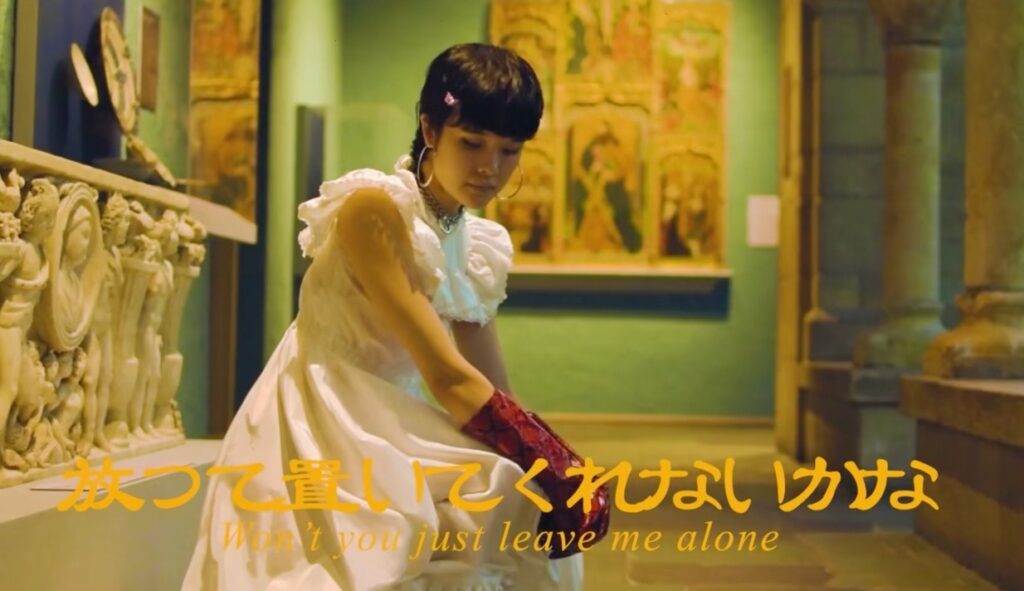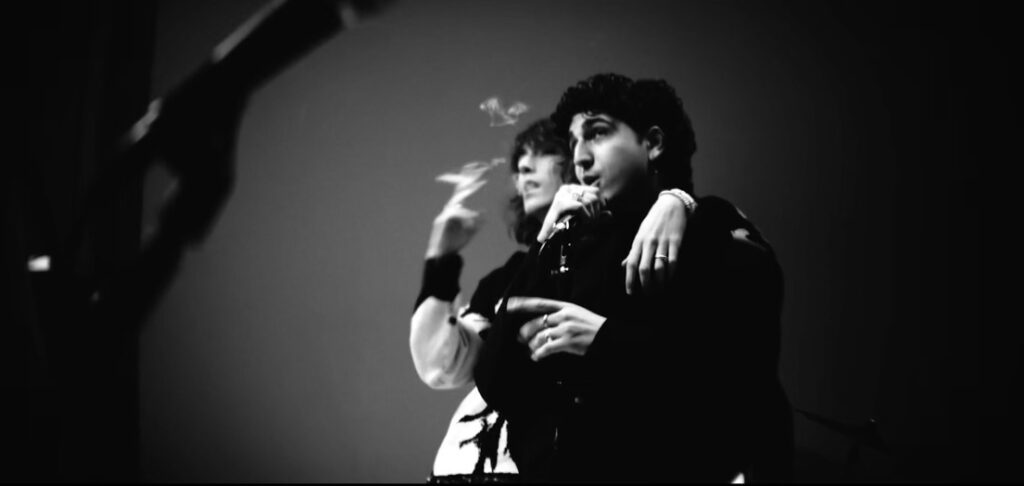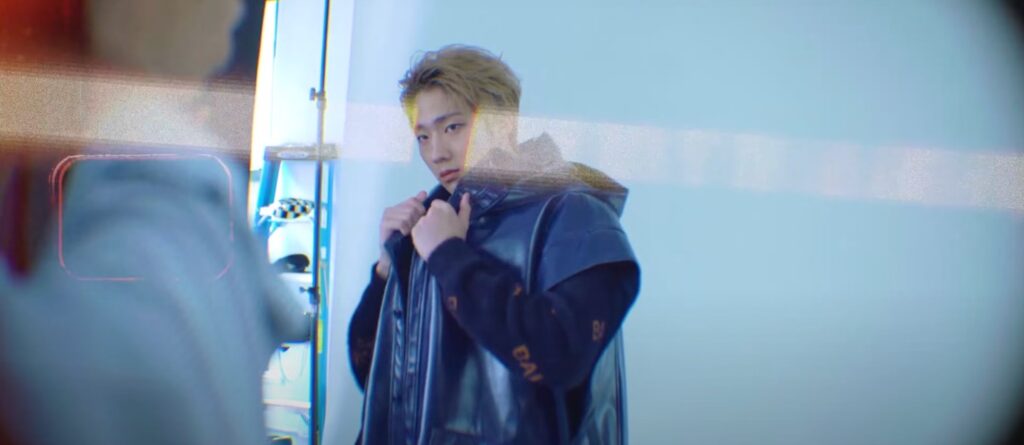For the first edition of Behind the Board, a series of interviews exploring emerging talents cultivating the new vanguard of music from behind the scenes, or, behind the mixing board, we’re picking the brain of videographer Evan Deng, founder of NYC-based Family Video Store collective. Deng has shot videos for viral sensation INJI, K-Pop stars P1Harmony, editorial work for FADER Korea, and PC Music star Namasenda.
How did you begin shooting music videos? I see you also have a background in visual art – how does that influence your work today?
Like anything that ever holds weight in this world, my first music video shoot was a product of sheer coincidence. I was taking a gap year from film school and staying in Ann Arbor, Michigan with some friends. Some friends of friends knew Mei Semones, who went to Berklee School of Music and was home for Thanksgiving. I messaged her on Instagram, asking if she wanted to make a music video and surprisingly, she said yes. She only had one song out at the time, but I knew in my soul she was someone special. We ended up making a video for “Muchuu,” her second single, and I remember some Zoom calls where I was just so shocked she was vibing with all my ideas. Like BDSM bunny mask, check; putting a mattress in the woods, check. I’ve always had strange interests growing up, and I love film as an art form because there’s just so much depth and symbolism and history you can imbue in a single shot. I think my experience in visual arts, specifically painting, really informed that passion.

What brought you to NYC all the way from sunny LA? How do you feel that transition along with your environment has affected your artistic practice?
My friends say I’m a very spontaneous person, so it’s funny you ask. I moved to New York this past March in a completely spontaneous decision, almost made overnight. I was actually here on vacation with a former situationship, but he was kind of an asshole and never paid me back for the hotel. While I was here though, I got invited to a party by a few fashion photographers who I linked with through Instagram. They really liked my work and I don’t know, it just felt like a sign.
The transition was difficult for my work just because New York is so expensive. I just got approved for food stamps this week. Much of my brand relies on on-location guerrilla filming, like at museums or laser tag, and it’s just a lot more difficult to sneak a camera into certain places in New York.
What’s a piece of media that speaks to you deeply right now, and why?
Ahh, that’s a tough question. Right now I’m obsessed with this Japanese horror film called Tetsuo: The Iron Man (1989). Super weird black-and-white movie from the 80’s about, to quote the Wikipedia summary, a metal fetishist driven mad by the maggots wriggling beneath his skin. The zaniness of the whole premise is just so fascinating, although disturbing, and the sound design is literally prototypical hyperpop. Speaking of hyperpop, my greatest muse, at least musically, is SOPHIE as well as the entirety of the PC Music collective.
What’s a past project that’s surprised you? What’s one you’re really proud of? What’s a funny, clever, or interesting detail in a music video that people might not initially notice?
I think the most surprising project I’ve been a part of is the video for “Madeline” by INJI. She made that viral “gaslight, gatekeep” song on TikTok, and we were kinda talking for a while but no concrete plans ever materialized. Then, just a few days before her single release party, she messaged me asking to shoot a music video.
I showed up to the pregame with nothing but a dinky $80 Nikon camera and these portable orange lights, proceeded to get really drunk, went to the party, and I literally don’t remember anything else from the night. But when I got home, I was literally blown away with how good the footage looked even though I’m pretty sure I was blacked out.
I love Easter eggs, and I always try to include them in my work. One really minor Easter egg that I swear nobody noticed is that we used the same Greek head sculpture from Mei Semones’ “Muchuu” video in her latest video for “Okashi.” Super minor detail but I thought it would be a fun nod, mostly for myself. It was my Greek head, I think I got it from Anthropologie.
I’d love to hear about the origins of Family Video Store. What inspired you to start the collective. How did you come up with the name?
Interestingly enough, Family Video Store started off as a band—me and a friend who could barely sing and play guitar. I think we released a couple songs on Spotify but they flopped, so I repurposed the name into a video production company. I’ve always loved music; I constantly had earbuds in as a kid so I didn’t have to hear my parents yell at me. I was a pretty mischievous child and got into trouble a lot. I think the name is fitting though because Family Video, the company, officially went bankrupt right when I started the music video company. I miss places like that. I feel like video rental stores like Blockbuster really democratized the moviegoing experience. In a way, I want Family Video Store to do the same and democratize the music video, if that makes any sense.
Common throughout Family Video Store’s music videos is maybe not an aesthetic but a feeling of bold, spontaneous DIY spirit. What things – whether moments, pieces of media, dreams and thoughts, have influenced your unique artistic identity?
I love this question because I truly believe that in order to be a great artist, you have to learn to steal. I consider my best work to be a smorgasbord of the weirdest, tackiest, and campiest things I’ve seen, touched, and tasted since I was a kid. I love textures, like pleather, rubber, and snakeskin. I grew up watching Super Sentai, which is basically the original Japanese version of Power Rangers. I love their bright, vibrant costumes and the color coding—there’s always a red, blue, green, yellow, and pink ranger. Then mid-season, they introduce a sixth ranger, who is oftentimes gold or silver, or based on some precious metal. Stylistically, color has always been important to me, and I love old Technicolor films for that reason. I really love John Waters and I’m a huge fan of camp—I think people who don’t like camp have a stick up their butts. There’s also a Japanese horror film called House (1977) that I love, and a Czechoslovakian art film called Daisies (1966) that has been incredibly influential towards my style. I come from a very cinephilic background, and I’m really inspired by cinema verité, Dogme 95, and French New Wave in terms of editing, camera movement, and their non-linear narratives and spontaneous direction. Other films worth mentioning are Harmony Korine’s Gummo (1997), Gaspar Noé’s Enter the Void (2009), and this one movie called Symbiopsychotaxiplasm (1968). I’ve also seen the Alvin and the Chipmunks movies like 8 times. I have very vivid dreams and I always try to write them down when I wake up. A lot of aspects from them have ended up in my work, or I’ve put them aside for future projects.
The range of artists that you work with also spans genre, demographic, and stage of career (from stars like Namasenda to rising talents like Mei Semones and Frances Baker). Collaboration is key for creatives. How do you choose who you work with, and what constitutes a fulfilling partnership?
Typically the artists I work with are people I’ve been talking to for a while, or friends of friends of friends, or something of that nature. I love it when artists bring a song to the table and have a narrative structure in mind, but leave the visual components open-ended. I consider my direction to be similar to a sandbox in a playground, with trucks and shovels and every toy imaginable in there. My sets are very lax and intimate and tend to be made up of skeleton crews. What’s most important to me is that everyone feels comfortable and is having fun. I don’t think you can make good art if people aren’t having fun making it. My only responsibility is to get everyone in the sandbox, provide them with the toys, and whatever sticks, sticks. The video will always turn out good; I just have to allow them that environment to explore and experiment and try things that you wouldn’t normally try on bigger productions.

How would you say music videos as a medium translate across cultures and do you find yourself learning/working in different ways when working with, say DAZED Korea or P1Harmony vs American artists?
I think since its primitive inception, music has always been a universal language of sorts. Even if the words don’t always make sense, melodies do. Harmonics do. While it’s definitely a lot different to work with artists from different countries. I don’t find it necessarily more challenging. The camera has no language barrier, it is simply a reflection of our world on a purely visual level. Luckily, I’ve always been drawn to international cinema (French, German, Swedish, Japanese, and Korean specifically) and in turn, my art seems to resonate with people from many different backgrounds. I consider myself an eternal student, and so I definitely do learn a lot working with artists from different cultures and nationalities. My process, however, tends to stay the same. Images have a powerful way of conveying pathos and emotion, whether you recognize it or not, and we, as human beings, are globally connected in that way.

Certain images can translate much differently across different cultures, and I suppose that’s why I tend to lean towards minimalism in my work. I like to keep my concepts sparse and free of contemporary trends. Instead, I try to make videos that feel timeless and unaffected by geographical barriers.
Family Video Story is proudly queer Asian owned and champions BIPOC, Asian, and Queer artists. How does your heritage and identity inform the art you create?
I think a lot of POC go through this phase of internalized racism and self-hatred, in what I consider the dark days of our youth. What I want people to know is that it’s not your fault for feeling that way at some point. Society and mass media literally condition us from a young age to be racist, homophobic, and misogynistic from the movies we watch to the archaic grammatical conventions we learn in school.
As a queer Asian creative, I feel like I have the responsibility to create art and create spaces that are not only diverse and inclusive, but also actively work towards dismantling white supremacy, whether through working with queer BIPOC, or simply approaching the filmmaking process from a non-standard, anti-hierarchical method.
Asian creatives have been experiencing a sort of renaissance in Western pop culture in recent years. What do you feel like your role in this creative legacy is?
The film industry and the history of cinema in general is inherently incredibly racist, and my hope for Family Video Store is to build a platform for people of color to truly feel included, seen, and understood. I also want to inspire young filmmakers like me to pick up a camera and make something cool, even if they don’t have a massive budget or the video doesn’t look “professional.” Family Video Store is for the girls and the gays, and if you don’t vibe with that, that’s on you.


So insightful!